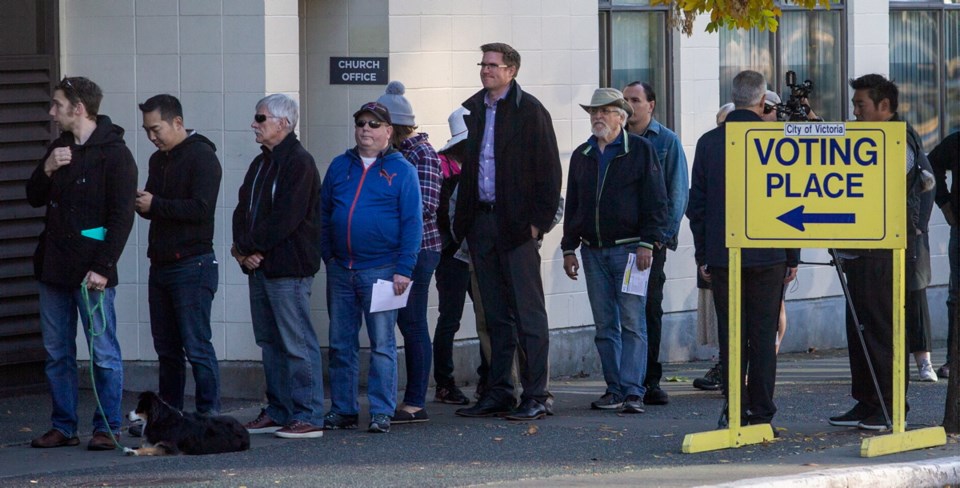The City of Victoria is blaming high voter turnout for long waits at polling stations Saturday, but the people forced to stand in line say that’s a poor excuse for bad planning.
The city admits there were waits of up to an hour at some stations, although voters argue they were longer than that.
The lines meant the city was forced to delay vote counting so that anyone still in line when the polls closed at 8 p.m. could cast their ballots. In some cases, people were still voting more than an hour later.
“As you know, turnout was up significantly from last election — it was the highest in recent history,” Bill Eisenhauer, the city’s head of engagement said in a statement.
“At times waits were between 20 minutes and up to an hour or so at some polling stations. It varied throughout the day depending on the voting place.”
> For more election coverage, go to timescolonist.com/elections
City residents counter that the voting system should be able to withstand a bump in voter turnout.
The city says 29,707 or 43.5 per cent of registered voters cast ballots Saturday, compared with 24,665 or 39 per cent of registered voters in 2014.
The voters, instead, blame delays on the fact each polling station had just one machine to read the ballots that voters mark by hand.
Jonathan Purdie, who voted at Margaret Jenkins Elementary, said he waited from 5:30 p.m. until just before 7 p.m. to cast his ballot.
“I couldn’t believe that there was just one machine,” he said.
“What would happen if 65 per cent or 70 per cent [of Victoria’s] eligible voters had showed up?
“I just think in our democracy it’s unacceptable to be in line for an hour and a half to vote.”
John Hutchinson said he went to Margaret Jenkins Elementary around lunch time, took one look at the lineup and decided to come back later.
He returned around dinner time and found exactly the same situation. He gave it one more try 15 minutes before the poll closed at 8 p.m.
He finally cast his ballot at 9:15 p.m.
Like Purdie, Hutchinson blamed the waits on a shortage of voting machines. He timed people using the lone machine at the school and said it took each person anywhere from 30 seconds to a minute to use.
The city claims it takes about 15 seconds on average for the machine to read the ballot. The city used double-side ballots for the first time this year, which added a couple of seconds to the process, the city said.
Either way, Hutchinson said he doesn’t buy the argument that high voter turnout is to blame. “That’s just an excuse,” he said. “For the amount of people that they had, I would have thought that four machines would have been a good amount.”
Mayor Lisa Helps seemed to agree with the residents.
“I think we probably need more of those machines because I think that was the bottleneck,” she said. “Where the ballots were being fed into the machines, I think that’s where the crunch was.”
Council will wait for a staff report before making any decisions.
Eisenhauer said the chief election officer does a routine review after each election and will make adjustments as needed.
“The number of voting machines at polling stations is one part of the voting process and will be part of the review,” he said.
The review following the 2014 election did not identify any specific problems with voting places or lineups, he said. The city used 12 polling stations and rented machines this year just as it did in 2014.



